Ag Leader SMS Basic, SMS Advanced User Manual

SMS Basic and Advanced Manual
Table Of Contents |
|
Introduction ............................................................................................................................................................................ |
1 |
Introduction......................................................................................................................................................................... |
1 |
System Requirements to Run the Software ....................................................................................................................... |
1 |
Things You Should Know to Run the Software .................................................................................................................. |
1 |
Getting Started ................................................................................................................................................................... |
4 |
Registering Your Software ................................................................................................................................................. |
4 |
How to Use the Electronic Help ......................................................................................................................................... |
6 |
User Interface ........................................................................................................................................................................ |
7 |
Menus................................................................................................................................................................................. |
7 |
Main Windows .................................................................................................................................................................. |
22 |
Data Processing................................................................................................................................................................... |
53 |
Processing Data ............................................................................................................................................................... |
53 |
Syncing With SMS Mobile................................................................................................................................................ |
53 |
Data Management ............................................................................................................................................................... |
55 |
Data Management............................................................................................................................................................ |
55 |
Workspaces...................................................................................................................................................................... |
55 |
Projects ............................................................................................................................................................................ |
56 |
Mapping and Viewing Data.................................................................................................................................................. |
59 |
Mapping Data ................................................................................................................................................................... |
59 |
Map Backgrounds ............................................................................................................................................................ |
59 |
Layering............................................................................................................................................................................ |
60 |
Data Playback (ADVANCED)........................................................................................................................................... |
60 |
3D Mapping and Plotting (ADVANCED) .......................................................................................................................... |
60 |
Legends ............................................................................................................................................................................... |
63 |
Legends............................................................................................................................................................................ |
63 |
Creating and Editing Data.................................................................................................................................................... |
65 |
Creating Data ................................................................................................................................................................... |
65 |
Editing Data...................................................................................................................................................................... |
68 |
Jobs and Tasks.................................................................................................................................................................... |
71 |
About Jobs and Tasks...................................................................................................................................................... |
71 |
Creating and Editing Jobs and Tasks .............................................................................................................................. |
71 |
Exporting Jobs and Tasks................................................................................................................................................ |
71 |
Data Analysis and Modification............................................................................................................................................ |
73 |
Data Modification and Creation........................................................................................................................................ |
73 |
Analysis Wizard (ADVANCED) ........................................................................................................................................ |
74 |
Multi-Project Analysis (ADVANCED)................................................................................................................................ |
76 |
Spatial Data Finder (ADVANCED) ................................................................................................................................... |
76 |
Financial Tracking ............................................................................................................................................................ |
77 |
Booklet Printing (ADVANCED)......................................................................................................................................... |
77 |
Importing/Exporting Data and Setup Information................................................................................................................. |
79 |
Importing Data.................................................................................................................................................................. |
79 |
Exporting Data.................................................................................................................................................................. |
80 |
Device Setup .................................................................................................................................................................... |
82 |
Printing (Reports, Charts, Map Layouts, etc)....................................................................................................................... |
85 |
Printing ............................................................................................................................................................................. |
85 |
Data Backup, Transfer, and Maintenance ........................................................................................................................... |
87 |
|
iii |
SMS Basic and Advanced Manual |
|
Backing up and Restoring Data........................................................................................................................................ |
87 |
Transfer Settings, Setup Files, Etc................................................................................................................................... |
87 |
Database Maintenance .................................................................................................................................................... |
89 |
How to ................................................................................................................................................................................. |
91 |
How to read logged data files into the system. ................................................................................................................ |
91 |
How to migrate your data from Precision Map 2000 or Instant Yield Map Software........................................................ |
91 |
How to import Greenstar data. ......................................................................................................................................... |
92 |
How to reprocess data. .................................................................................................................................................... |
92 |
How to set your map projection........................................................................................................................................ |
92 |
Using the Management Tree............................................................................................................................................ |
93 |
Using the Preview Window............................................................................................................................................... |
93 |
Using the Calendar View. (ADVANCED) ......................................................................................................................... |
94 |
How to make a map ......................................................................................................................................................... |
94 |
How to Add a Layer to a Map........................................................................................................................................... |
95 |
How to display the 3D Terrain View. (ADVANCED)......................................................................................................... |
95 |
Using the Layer Window .................................................................................................................................................. |
96 |
How to adjust layer and attribute/property options........................................................................................................... |
96 |
How to edit point data....................................................................................................................................................... |
97 |
How to straighten a pass on a point dataset. ................................................................................................................... |
97 |
How to edit a legend......................................................................................................................................................... |
97 |
How to freeze a boundary. ............................................................................................................................................... |
98 |
How to create a new attribute........................................................................................................................................... |
98 |
How to create a new property. ......................................................................................................................................... |
98 |
How to create/edit a custom Operation. (ADVANCED) ................................................................................................... |
99 |
How to define Products .................................................................................................................................................... |
99 |
How to add a property to a management item or dataset. ............................................................................................. |
100 |
How to edit property data. .............................................................................................................................................. |
101 |
How to enter Financial Tracking entries......................................................................................................................... |
101 |
How to generate a Financial Tracking report. (ADVANCED)......................................................................................... |
102 |
How to create a 3D Plot. (ADVANCED)......................................................................................................................... |
103 |
How to create a boundary. ............................................................................................................................................. |
103 |
How to edit a boundary. ................................................................................................................................................. |
104 |
How to create a crop plan. ............................................................................................................................................. |
104 |
How to edit a crop plan................................................................................................................................................... |
105 |
How to create a generic dataset. ................................................................................................................................... |
105 |
How to use the Average Data by Polygon Tool. (ADVANCED) ..................................................................................... |
105 |
How to use the Vector Overlay Tool. (ADVANCED) ...................................................................................................... |
106 |
How to edit generic data................................................................................................................................................. |
106 |
How to create a guidance dataset.................................................................................................................................. |
106 |
How to create navigation points. .................................................................................................................................... |
107 |
How to edit navigation points. ........................................................................................................................................ |
107 |
How to create a variable rate prescription...................................................................................................................... |
107 |
How to edit a prescription dataset.................................................................................................................................. |
108 |
How to create a soil sampling dataset. .......................................................................................................................... |
109 |
How to edit soil sampling data........................................................................................................................................ |
110 |
How to add Buffer Regions to an object. (ADVANCED) ................................................................................................ |
111 |
How to edit an image. (ADVANCED) ............................................................................................................................. |
111 |
How to create spatial notes............................................................................................................................................ |
111 |
How to edit spatial notes. ............................................................................................................................................... |
112 |
iv
|
Table Of Contents |
How to create associated data....................................................................................................................................... |
112 |
How to edit an associated dataset. ................................................................................................................................ |
112 |
How to create split planter data...................................................................................................................................... |
113 |
How to add a simple analysis function(s)....................................................................................................................... |
113 |
How to edit a simple analysis function(s). ...................................................................................................................... |
115 |
How to remove a simple analysis function(s)................................................................................................................. |
115 |
How to merge cotton pickings. ....................................................................................................................................... |
116 |
How to straighten a pass on a point dataset. ................................................................................................................. |
116 |
How to update a merged cotton dataset. ....................................................................................................................... |
116 |
How to generate correlation results. (ADVANCED) ....................................................................................................... |
116 |
How to generate a cluster analysis dataset. (ADVANCED) ........................................................................................... |
117 |
How to generate comparison results. (ADVANCED) ..................................................................................................... |
118 |
How to run a batch comparison analysis. (ADVANCED) ............................................................................................... |
119 |
How to write an analysis equation. (ADVANCED) ......................................................................................................... |
120 |
How to generate a Multi-Year averages dataset. (ADVANCED) ................................................................................... |
122 |
How to generate a Profit/Loss dataset. (ADVANCED)................................................................................................... |
123 |
How to generate an NDVI dataset. (ADVANCED) ......................................................................................................... |
124 |
How to generate a terrain analysis dataset. (ADVANCED) ........................................................................................... |
125 |
How to search for spatial data using the Spatial Data Finder. (ADVANCED)................................................................ |
125 |
How to save a workspace. ............................................................................................................................................. |
126 |
How to open a workspace.............................................................................................................................................. |
126 |
How to geo-reference an Image..................................................................................................................................... |
126 |
How to download imagery from the internet................................................................................................................... |
126 |
How to set a map background(s). .................................................................................................................................. |
128 |
How to manually move a Farm....................................................................................................................................... |
128 |
How to create a Job and Task(s). .................................................................................................................................. |
128 |
How to export a Job. ...................................................................................................................................................... |
129 |
How to manually move a Field. ...................................................................................................................................... |
129 |
How to manually move other management items (Year, Load, etc.). ............................................................................ |
130 |
How to spatially sort Fields into Farms........................................................................................................................... |
130 |
How to spatially sort Loads/Regions into Fields............................................................................................................. |
130 |
How to split and sort a load or region............................................................................................................................. |
131 |
How to query a single layer............................................................................................................................................ |
131 |
How to query multiple layers. ......................................................................................................................................... |
132 |
How to export a bitmap or other image file type............................................................................................................. |
132 |
How to import an image file............................................................................................................................................ |
132 |
How to import an ESRI Shape, MapInfo Mid/Mif, DEM, or TIGER file........................................................................... |
133 |
How to batch import data (i.e. ESRI Shape,and text files). (ADVANCED)..................................................................... |
134 |
How to export an ESRI Shape file.................................................................................................................................. |
134 |
How to import an ASCII text file. .................................................................................................................................... |
135 |
How to import non-spatial data (i.e. Soil Lab Results). .................................................................................................. |
135 |
How to export an ASCII text file. .................................................................................................................................... |
136 |
How to import data using a template.............................................................................................................................. |
136 |
How to export a TGT prescription file............................................................................................................................. |
137 |
How to export an Insight/EDGE/INTEGRA IRX Prescription File .................................................................................. |
137 |
How to export a Case IH or New Holland Voyager PRD Prescription file...................................................................... |
138 |
How to export an Ag Leader Basic or Advanced format file........................................................................................... |
138 |
How to print a map of the current layer. ......................................................................................................................... |
138 |
How to print a map of all layers...................................................................................................................................... |
139 |
v
SMS Basic and Advanced Manual |
|
How to print the current map.......................................................................................................................................... |
139 |
How to print a custom map............................................................................................................................................. |
139 |
How to print the Summary Window Information............................................................................................................. |
140 |
How to print the Map Window summary information...................................................................................................... |
140 |
How to print the query results information...................................................................................................................... |
140 |
How to print a report....................................................................................................................................................... |
140 |
How to create a custom report. (ADVANCED)............................................................................................................... |
141 |
How to print a chart. ....................................................................................................................................................... |
142 |
How to create a custom chart. (ADVANCED) ................................................................................................................ |
142 |
How to create a backup of your systems data. .............................................................................................................. |
143 |
How to restore a data backup file................................................................................................................................... |
143 |
How to export and import Transfer Information.............................................................................................................. |
143 |
Troubleshooting ................................................................................................................................................................. |
145 |
Mapping Problems ......................................................................................................................................................... |
145 |
Printing Problems........................................................................................................................................................... |
145 |
Restore Problems........................................................................................................................................................... |
146 |
Tutorial Problems ........................................................................................................................................................... |
146 |
Reference Information ....................................................................................................................................................... |
147 |
Glossary of Terminology ................................................................................................................................................ |
147 |
GPS Coordinate Conversions ........................................................................................................................................ |
148 |
Ag Leader Basic and Advanced format.......................................................................................................................... |
149 |
Export Data Formats ...................................................................................................................................................... |
150 |
SDTS to DEM Converter (ADVANCED)......................................................................................................................... |
151 |
Index .................................................................................................................................................................................. |
153 |
vi

Introduction
Introduction
Ag Leader Technology is proud to offer SMS Basic/Advanced to you and thanks you for using our software. SMS stands for Spatial Management System . The word "Spatial" means involving or relating to space. That’s exactly what your Farm and Fields are. The space where you are involved (working) every day and the space that relates to all your business decisions.
SMS is the easiest to use, yet most powerful precision farming software package available for use with your Ag Leader equipment. It provides unique features to support all the Ag Leader precision farming equipment that you currently own and also helps integrate information that you may have from other sources or equipment. Simply put, you have chosen a software package that will continue to grow and adapt with your Ag Leader equipment, current and future, which no other software package will be able to match.
System Requirements to Run the Software
The following table outlines the minimum system requirements that are advised you meet in order to run the software properly.
|
Components |
|
|
Minimum Requirements |
|
|||
|
|
|
Basic |
|
|
Advanced |
|
|
|
|
|
|
|
|
|
||
|
Processor |
|
Pentium III or |
|
Intel iCore 5 or 7 |
|||
|
|
Equivalent |
|
(2 GHz or higher) |
||||
|
|
|
|
|
||||
|
Operating System |
|
Windows XP |
|
Windows 7(SP1)/ |
|||
|
|
|
|
(SP3)/Vista |
|
|||
|
|
|
|
(SP2)/Windows |
|
Windows 8 (Not |
||
|
|
|
|
7(SP1)/Windows 8 |
|
RT) |
||
|
|
|
|
(Not RT) |
|
|
|
|
|
Memory |
|
1 GB RAM |
|
6+ GB RAM |
|||
|
Application/Data |
|
4 GB |
|
12 GB+ |
|||
|
Storage Space |
|
|
|||||
|
|
|
|
|
|
|
||
|
Media Drive |
|
CD-ROM or DVD- |
|
CD-R or CD-RW |
|||
|
|
|
|
ROM |
|
Drive |
||
|
Monitor size |
17" |
|
19" |
|
|||
|
Display Resolution |
|
1024x768 at 16-bit |
|
1280 x1024 or |
|||
|
|
|
|
|
higher at 24/32 bit |
|||
|
|
|
|
color |
|
|||
|
|
|
|
|
color |
|||
|
|
|
|
|
|
|
||
Things You Should Know to Run the Software
The software was developed with the Windows family of operating systems in mind. The software takes advantage of many standard features of the Window’s operating systems that you might not be familiar with, but can greatly enhance your productivity. The following is a list of Windows features that the software uses to provide increased functionality and ease-of-use:
Keyboard
Shift key
When used along with the mouse, this allows the selection of multiple, continuous items at once. For example if you select an item in the Management Tree then press and hold the Shift key down, then click on another item in the Management Tree, all the selections between your first and last selections will be highlighted and selected. Release the Shift key and the items will remain selected until the next selection with your mouse.
Ctrl Key
1
SMS Basic and Advanced Manual
When used along with the mouse, this allows the selection of multiple non-consecutive items. For example if you wanted to select two fields from the Management Tree to map at the same time but there were 4 fields in the list between them, you would move your cursor over the first field, click the left mouse button to highlight and select it. Then press and hold the Ctrl key and repeat the previous step to select the other field. Now release the Ctrl key and both fields will remain selected until your next mouse click.
Arrow Keys
Allow the user to move through selected lists instead of using the mouse to make each selection. This can be used to quickly move up and down in the Management Tree if a selection has already been made in the tree with the mouse. It also allows the opening/closing of a branch in the tree. When a map is active in the software the arrow keys also serve as panning tools.
" + " and " – " Keys on Numeric Keypad
Use these keys to zoom in and out on a map.
Home Key
Press this key to zoom and world and center the data in question.
F1 Key
Pressing this key brings up the help for the current selection.
Shortcut Key
Pressing this key will bring up the shortcut menu for the currently selected window. This key is commonly located next to the right CTRL key. It can also be accessed by pressing SHIFT + F10.
Other Keyboard Shortcuts
Function Key(s) to Press to Activate Functions
Measure CTRL + M Multi-Line Measure CTRL + L Copy Selection CTRL + C
Paste |
CTRL + V |
Cut Selection CTRL + X |
|
Undo |
CTRL + Z |
Redo |
CTRL + Y |
Reset Cursor END
Delete Selection DELETE
Move Selection CTRL + E
Merge Selections CTRL + R
Snap to Start Point F2
Snap to Center F3
Snap to Midpoint F4
Snap to Endpoint F5
Snap to Closest F6
Snap to Vertex F7
Snap Off F8
Mouse
Clicking on an object or area
Point the cursor to or over the desired object or area and press the left mouse button once and release.
Double clicking
Point the cursor to or over the desired object or area and quickly press and release the left mouse button twice.
Dragging Objects
2
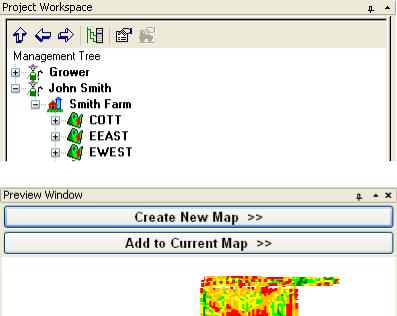
Introduction
To drag an object such as a window, move your cursor over the object, click and hold down the left mouse button, and then move the object to the desired location and release the left mouse button.
The Wheel
If you have a Windows operating system that supports a mouse with a wheel, such as the MS Intellimouse, then you can use the wheel for several functions, if your mouse has a wheel.
Scrolling – If a scroll bar is available in a window or dialog, move the cursor into that window or dialog and roll the wheel forward or back and the scroll bar should move accordingly.
Zoom – Holding the Ctrl key down and rolling the wheel forward or back zooms the current map in and out. This will even work on the Preview Window if the cursor is located over it.
Pan – Rolling the wheel forward or back, pans the current map up and down. Holding the Shift key down and rolling the wheel forward and back will pan the current map left and right. This will also work on the Preview Window if the cursor is located over it.
Adjusting and Docking Windows
All the windows that comprise the software’s main window can be adjusted to a different size, and some can be undocked from there current location and moved around the screen as separate windows from the main window. To adjust the size of a window move your cursor over the border of a window until you see a symbol with two parallel bars and arrows on each side. When this icon appears click and hold the left mouse button and drag the edge to adjust the size of the window. This is most useful for adjusting the size of the Layer window to view more of the legend, or the opposite to see a larger map. To undock windows, and view them as separate floating windows, click on the gray double bar above a window, click and hold the left mouse button down, and drag the window to a new location. The window will now appear as a separate window from the main window. To re-dock the window with the main window, click and hold the left mouse button down in the area at the top of the window and drag the window until your cursor crosses one of the edges of the main window. The window will then automatically dock.
Hiding/Collapsing the Management View or Preview Windows
3
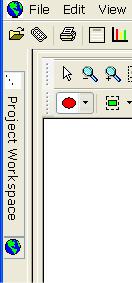
SMS Basic and Advanced Manual
The Management Views window and the Preview window have options in the upper right hand corner of the windows that allow you to hide/minimize the windows or collapse/expand the windows up/down to maximize/minimize their display. Clicking on the "pushpin" icon so that it points sideways will cause the window to "hide". When it does this the window will hide to the left edge of the screen and only be visible, as shown above, as a vertical tab(s). Move your cursor over the tab and the window will expand out to its full size. When you move your cursor off the expanded window it will automatically hide again. To un-hide a window then click the "pushpin" icon when the window is expanded so that it points down and the window will remain visible.
The other option is to expand/collapse the windows vertically. To do this, click the "arrowhead" icon to the right of the "pushpin" icon in one of the windows shown above and the window will either expand up/down vertically to fill the window area available. This will cause the window above or below it to effectively hide. Click the icon again to return the window to its default state.
Shortcut Menus
Shortcut menus appear when you move your cursor over an object and click the right mouse button. Shortcut menus provided access to specific feature for an object or a quicker method of getting to common functions. The Shortcut Key or SHIFT + F10 can also provide access to the shortcut menu.
Getting Started Installation
If you haven’t already done so, install the software on your computer. It is recommended that you install it on a storage drive other than your main boot drive that contains your operating system, which is normally your C:\ drive. This is especially true if your C drive is partitioned and is less than 10GB in size. The reason for this recommendation is due to the amount of data that must be stored and is generated by your precision farming activities. If you have a smaller C drive you could quickly fill the drive up or hinder performance of your computer by using to much of the boot drives storage and operation memory. The software does allow you to install the actual program on a different drive than where you data and database are stored. For example you can install the actual program on your C drive but have all your data stored on a second drive.
Follow these steps to install the software on your computer from a CD:
1.Insert the software CD into your CD-ROM or DVD-ROM drive. The CD menu should now automatically startup, if it does not, then click on the My Computer icon and open your CD-ROM or DVD-ROM drive by doubleclicking on it.
2.Follow the directions on the screen to install the software.
Migration
Each new release normally only supports migration and restoring backups from the previous version of the software. Please see the current release notes for the details on what versions are supported for migration.
Registering Your Software
The software requires an unlock code to give you unlimited mapping and data creation capability. You have 21 days to try the program before the program will require an unlock code provided by Ag Leader Technology . Once you have
4
Introduction
received your code you will be able to make unlimited maps and be entered into the Software Maintenance program which guarantees that for the first year after you purchase the program, you will receive all minor and major software releases automatically at no additional cost. After the first year you will be required to pay an annual maintenance fee to maintain your status in the maintenance program.
To unlock the software follow these steps:
1.Create a map and the registration wizard window will appear, or go to the Help menu and select Register.
2.If you selected the Register option from the Help Menu, the License Manager dialog will now appear. This dialog displays the software versions and options that you can potentially unlock. Select the item from the list that you wish to unlock and click the Register button.
3.Now the Registration Wizard Window will open. Select one of the Registration Options and then click the Register button. If you have an internet connection, please use the Online option. If you do not have any
type of internet service then you will need to use the Phone option to register your software.
1.
4.If you selected the Online registration option please follow these steps.
1.The first step is to log-in or create a registration account for the software. If you already have or were provided a Username and Password, you can enter them and log-in, otherwise you need to create a new registration account. To do this, select the Create New Account Button. You will now be prompted to enter in your contact information from your address to your email address. You must enter a valid email, otherwise you can not successfully register.
2.Once you have created the new account and it has been accepted, your Username and Password will automatically be filled in for you on the Login screen and you will be emailed your Username and Password for your records. Now click the LOGIN button.
3.Once you have registered and entered your login information, and clicked the LOGIN button, you will now be prompted to enter your activation code. The activation code is attached to the outside of your CD case.
5.If you selected the Phone registration option please follow these steps.
1.The Phone Registration dialog should now be displayed.
2.If you are located in North America (English Support Only) call 1-515-232-5363, select Option 1 (Technical Support), and then the option for Desktop Software . You will be required to provide the Computer ID and Registration Code that are listed on the Phone Registration dialog. If you are an International customer then please contact your local Service Provider and they will help register you and get your unlock codes.
3.A registration account will be manually created for you and you will be provided with a username and password.
4.As long as it can be verified that you have paid for the software or are currently enrolled in the software maintenance program you will be provided with an unlock code that you can then enter into the available entry on the Phone Registration dialog.
6.The software should now indicate that the software has been unlocked and you now have full access to all
the functionality you paid for.
If you would like to run the software on more than one computer you can do so. You are allowed to unlock the software on two computers, with the stipulation that you won't be running them at the same time for work purposes. For
5
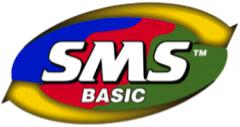
SMS Basic and Advanced Manual
example, you may have a laptop and desktop computer and would like both unlocked so that when you are in the field or traveling that you can fully use the software. Your registration account automatically allows you to get 2 unlocks automatically via the internet without contacting technical support.
See one of the topics below on registering your software: License Manager
Registration Login Create New Account Enter Activation Code
How to Use the Electronic Help
The Electronic Help is organized to help you learn how to use t quickly and effortlessly. The following outlines the different identifiers that you will encounter in this Help manual and what they mean:
"(ADVANCED)" - If you see this text next to a help topic title or an item in the help that means this feature/topic only applies to the Advanced version of the software. Anything else without this text next to it applies to all versions of the software. By default the software is sold as the BASIC version.
Text underlined in green indicates a link to another help page. Click on the text underlined in green to jump to another help page.
Text underlined with a green dotted-line links to a popup. Click on the text underlined with a dotted green line to see a popup.
Click on graphical icons to jump to another Help page or start a movie (w/o sound) - 
Some images can be clicked on to link to another Help page. Move your cursor over these images, when indicated by text below them, and then you see a "hand" icon appear click the left mouse button to go to the linked Help page.
6
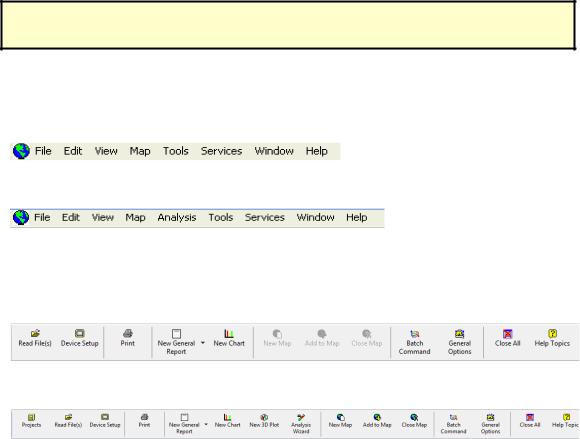
User Interface
Menus
Main Menu Selections and Toolbar
The Main Menu Selections allow you to access the core features, settings, and help for the system.
Basic menu:
Advanced Menu:
Move the cursor over an area you would like more information about and if a hand icon appears click the left mouse button to see more information.
Basic Toolbar:
Advanced Toolbar:
Move the cursor over an area you would like more information about and if a hand icon appears click the left mouse button to see more information.
File Menu
Summary Window File Options
7
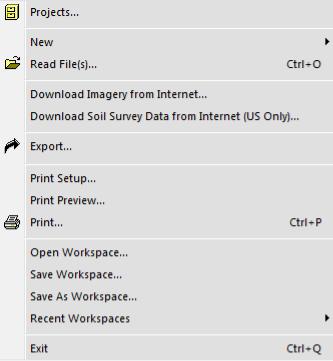
SMS Basic and Advanced Manual
Projects
Projects are normally used to separate data from different users or customers that you want kept in different databases for security or data size reasons. Advanced users can create, edit, or delete an unlimited number of Projects. Basic users can only create/edit/manage up to (5) Projects and are limited to a single Data Location where there data is stored. Advanced users can define multiple Data Locations to store data, which can be on the same computer or on individual servers spread out around the world.
New
Allows the creation of new views in the main window or datasets. You can create the following:
Map
3D Plot (ADVANCED) Chart
General Report
Scouting Report Financial Tracking Report Crop Plan(s)
Operation Summary Dataset Read File(s)...
Allows different types of files to be read into the software. Three options for reading in files are provided. Read File(s) from a Supported Field Display or Monitor
Files from Ag Leader Technology, AGCO, Case IH, CLAAS, Flexi-Coil, John Deere, New Holland, RDS, and Trimble can be read directly into the software. Options are provided for manually selecting files or automatically searching folders or hard drives/memory cards.
Sync/Import Projects from SMS Mobile
Allows the user to sync or import a Mobile Project from Ag Leader Technology's SMS Mobile software. This sync/import process can also update the Mobile project with newer information from your software, such as updated management item names or edited data.
Import a File from a Generic Source
Allows the user to import generic data files of the following types:
3D Surface Files (ADVANCED)
Allows the import of 3D surface files such as DEM's, NED's, LIDAR, and SDTS Elevation models.
8
User Interface
Images
Allows the import of BMP, JPEG, JPEG2000, GIF, MrSID, PNG, WMF, TIFF, or GeoTIFF image files. World files containing geo-referencing for the import image are also supported, if available, and will be automatically loaded if they are present in the same location as the image file you are importing.
Management Items Files (Product Lists)...
Allows the import of management items such as Products, Vehicles, and Field names. Generic lists of items can be imported from ASCII text files or specific formats such as the Management Setup File (.*MSF) or AgriDNA XML file.
MapInfo MID/MIF File
Allows the import of MapInfo files.
Non-Spatial File (Lab Results)...
Allows the import of ASCII text files that don't contain spatial (position) data that you need to import and link to spatial data already in the system, i.e. import Soil Lab Results and link them to a soil sampling points in the system.
Shape File
Allows the import of ESRI Shape files.
Text File
Allows the import of ASCII text files.
TIGER File
Allows the import of TIGER files.
Import a File Using a Saved Template
Allows the user to select an import template that was saved from a previous Spatial or Text file import to use on a new import file of the same type.
Download Imagery from Internet...
Allows the automatic downloading and import of aerial images from the internet. You must have an internet connection to use this feature and you should have either automatic, frozen, or set boundaries for fields in your system to get the best possible images available.
NOTE: No warranty or guarantee of imagery quality or availability is made when using this feature. Downloaded imagery is made available for the users own private use only and is not to be used for resale or commercial purposes.
Download Soil Survey from Internet (US Only)...
Allows the automatic download and import of soil survey data from the USDA via the internet. You must have an internet connection to use this feature and you must have either an automatic, frozen, or set field boundary for your fields in order to download the soil survey information. The available data may vary from region to region but as much technical detail as is available is downloaded for the soils that go with your fields.
NOTE: No warranty or guarantee of quality or availability is made when using this feature.
Export
Opens the export wizard dialog and allows the user to export data from the system using 3 possible methods:
Export to a Display Using Device Setup
Allows the export of files to supported field displays. This export option provides full setup for most supported displays, not just individual files.
Export to a Display With a Single File
Allows the export of individual files (boundaries, VR prescriptions, etc) to a supported field display. This export method has a smaller list of supported displays than Device Setup and many of the displays listed for this option are NOT available in Device Setup.
IBY File
Allows the export of a boundary dataset as an IBY file for use in the Ag Leader Insight display.
BDY File
Allows the export of a boundary dataset as a BDY for use in the Ag Leader PF3000 or PF3000 Pro
PFN File
Allows the export of a navigation dataset as a PFN file for use in the Ag Leader PF3000 or PF3000 Pro
TGT File
9
SMS Basic and Advanced Manual
Allows the export of a prescription dataset as a TGT prescription file for use in the Ag Leader PF3000, PF3000 Pro, or Insight displays.
IRX File
Allows the export of a prescription dataset(s) as an IRX prescription file for use in the Ag Leader Insight display. This format supports multiple product prescriptions.
PAT File
Allows the export of a guidance dataset as a PAT file for use in the Ag Leader Insight display with the AutoPilot option enabled.
FALCON File
Allows the export of a prescription dataset as a TIF or TRF/INI prescription file(s) for use in an AGCO/AGCHEM Falcon system.
Note: Your Falcon controller must be unlocked by AGCO to provide the ability to spread from TIF maps.
ENS File
Allows the export of a prescription dataset as an ENS prescription file set for use in Case IH AFS Concord and Cyclo systems.
PRD File
Allows the export of a prescription dataset as a PRD prescription file for use in the Case IH AFS PT and New Holland SP series planters running firmware that supports the Voyager file format.
PRE File
Allows the export of a prescription dataset as a PRE prescription file for use in the Case IH ADX or Flexi-Coil Flexcontrol systems.
ARM File
Allows the export of a prescription dataset as an ARM prescription file for use in Mid-Tech and Tyler/Case IH AIM systems.
GLN File
Allows the export of a guidance dataset as a GLN file for use in Mid-Tech displays.
Trimble Files
Allows the export of datasets as guidance, boundary, or prescription files for Trimble displays and mobile software.
EZ-Guide Plus Guidance File
Allows the export of a guidance dataset as a FLD file for use in an EZ-Guide Plus system from Ag Leader, Case IH, New Holland, and Trimble. Requires v2.0 or higher firmware in the EZ-Guide Plus and the latest version of the EZ-Toolbox program on your PC.
Remote Data Logger Files
Allows the export of a guidance dataset as a guidance file for use in the Remote Data Logger (RDL) from Case IH, New Holland, and Trimble.
Export Using a Generic File Format
Allows the export of data in generic formats.
Image Files
Allows the export of bitmap, JPEG, GIF, PNG, TIFF, or GeoTIFF image files.
Shape Files
Allows the export of ESRI Shape files.
KML (Keyhole Markup Language) File
Allows the export of Google KML files that can be used in Google Earth or other GIS applications.
Text Files
Allows the export of ASCII text files.
Ag Leader Basic File
Allows the export of an Ag Leader Basic comma delimited text file.
Ag Leader Advanced File
Allows the export of an Ag Leader Advanced comma delimited text file.
Print Setup
10
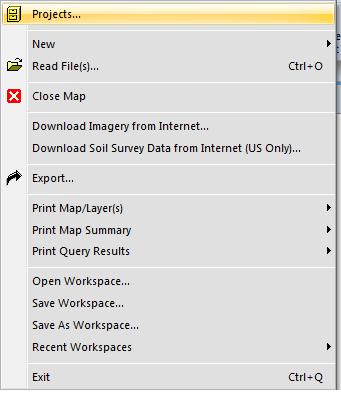
User Interface
Standard Window’s printer selection and setup options.
Print Preview
Provides a print preview of the information that is currently displayed in the Summary Window.
Prints the information that is currently being displayed in the Summary Window.
Print Report
Allows the user to print a Grower, Farm, or Field Summary report.
HTML Report
Allows the user to create the same type of reports as above but as an HTML page instead of printing to a printer.
Open Workspace
Allows the user to select a saved workspace to open.
Save Workspace
Allows the user to save the current map(s) and layer(s) that are open as a workspace that can be reopened at any time to return to the same map(s) and layer(s) that were open when the workspace was saved.
Save As Workspace
Allows the user to save the current workspace as a different name.
Recent Workspace
Allows the user to see a list of recent workspaces that have been used and select one to open. Exit
Closes the application.
Map Window File Options
The following menu items differ from those described above when the a Map Window is active:
New
11
SMS Basic and Advanced Manual
Allows the user to create one of the following dataset types:
Boundary Layer
Allows the user to create a new field boundary dataset.
Field Crop Plan Layer
Allows the user to create a new crop plan dataset for a single field. This option is only available if you have a field boundary open in the current map and the crop plan will be added for that field only.
Generic Layer
Allows the user to create a new generic dataset that can contain point, line, or polygon data. The user can also define and add new attributes for a generic dataset.
Guidance Layer
Allows the user to create a new guidance dataset to be exported to an assisted or automated steering system or to be used for field work planning.
Navigation Layer
Allows the user to create a new navigation point dataset.
Plot Prescription Layer (ADVANCED)
Allows the user to create a new plot prescription dataset that can be used for research/test plot design.
Prescription Layer
Allows the user to create a new prescription dataset.
Soil Sampling Layer
Allows the user to create a soil sampling dataset using a gridding wizard. Soil sampling lab results can then be imported and tied to the points.
Scouting Layer
Allows the user to create a scouting dataset(s) by drawing regions or gridding an area. Scouting data specific to different pests can also be created and saved as their own scouting operations based on pest type.
Tile Plan Layer (ADVANCED)
Allows the user to create a new tile plan dataset.
Map
Allows the creation of a new map based on your selection(s) in the Management/Monitor Tree , Calendar View, or Job/Task Tree.
Map Layer
Allows the creation of a new layer in the current map, based on your selection(s) in the Management/Monitor Tree , Calendar View, or Job/Task Tree.
Close Map
Closes the Map that is currently active.
Print Map
The following options are available for printing when a Map window is active:
Current Layer
Prints a map of only the current layer.
All Layers
Prints a map printout for each layer that is open on individual pages.
Current Map
Prints a map of all open layers on one page and then each of the available layers information printed on the following pages.
Custom Layout
Allows the user to design a completely custom printout that can include such items as bitmaps and text descriptions.
Print Map Summary
Prints a map summary report for the layers currently open in the active map.
Print Query Results
Prints a report of all the queries that have been performed in the active map.
Analysis Results Window File Options (ADVANCED)
12
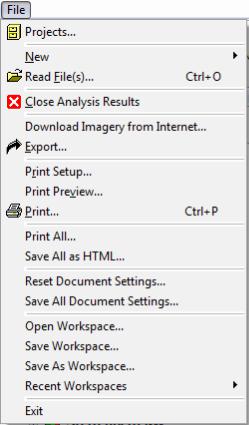
User Interface
The following menu items differ from those described above when the an Analysis Results Window is active:
Close Analysis Results
Closes the Analysis Results document window that is currently active.
Print All...
Prints all the results currently displayed in the analysis results document.
Save All as HTML...
Saves all the results currently displayed in the analysis results document as a single HTML file with links to each analysis result.
Reset Document Settings...
Select this option to clear any saved analysis document settings you have set back to the original defaults. Save All Document Settings...
Select this option to save all the settings you have made for the current analysis result and analysis function that was run to generate them. When you rerun the same analysis function, these saved settings will be loaded to automatically format your results the same way as when you saved. If you change the formatting or content of the results though, the settings will automatically return to the default settings for your current results only.
Edit Menu
Summary Window Edit Options
13
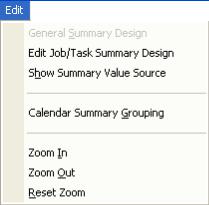
SMS Basic and Advanced Manual
General Summary Design
Allows the user to change what attributes and/or properties that are displayed in the General Summary window for the current operation selection in the management tree.
Job/Task Summary Design
Allows the user to change what attributes are displayed in the Job or Task summaries. The Job summary can only be edited when the Job node is selected in the Job/Task Tree. The attributes that can be selected for the Job summary are limited to ones that are generic across different modes, like Fuel Used. The Task summary can only be edited when a selection at the Operational Pair level down to Product is made. At the Operational Instance and below, the normal summary will be displayed and if you wish to change it contents then you must make these changes on similar data in the Management Tree.
Show Summary Value Source
Check this option to display symbols in the summary grid cells to the right of the values and units that identifies the source of the displayed data. The following data sources are available for display along with their symbols:
Monitor Summary - ‡ Spatial Data Records - † Manual Entries - «
Mixed Types - *
Calendar Summary Grouping (ADVANCED)
Allows the user to adjust the grouping of data that is displayed for the current calendar view selection in the General Summary window.
Zoom In
Select this option to zoom the current document view (i.e. the summary or a report) in, thus enlarging it.
Zoom Out
Select this option to zoom the current document view (i.e. the summary or a report) out, thus reducing its size.
Reset Zoom
Select this option to rest the zoom level to the system default for the current document view.
Map Window Edit Options
14

User Interface
Map Summary Design
Allows the user to change what attributes and/or properties that are displayed in the Map Summary window for the current layer and operation in the active map.
Layer
Allows the user to edit the data in the current dataset layer and active map, if editable.
Legends
Allows the user to edit the legend for the current layer in the active map.
Notes
Layer Notes
Allows the user to add a spatial note(s) to the current dataset layer. These notes are tied to the specific dataset they are added to and can only be viewed/edited when the same dataset is mapped.
Landmark Notes
Allows the user to add a landmark note(s) that will be displayed whenever spatial data is mapped. These landmark notes allow the marking and notation of permanent landscape features such as wells, pump heads, builds, etc.
Freeze Layer
Allows the user to freeze the current layer. By freezing a layer you can make adjustments to the dataset in the management tree for example and create a new layer or map which you can compare to the original dataset layer that you froze. If you had not frozen the layer then it would have been updated with any changes that you had made to the original dataset. The frozen dataset will only be accessible while you have the current map that contains it open. Once the map is closed or the layer is removed you can not reopen the frozen layer.
Layer Options
Allows the user to edit the layer, sub-layer, and attribute/property options for the current layer in the active map.
Map Options
Allows the user to edit the map options for the active map.
View Menu
Preview Window
15
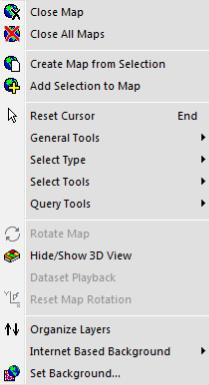
SMS Basic and Advanced Manual
Allows the user to turn the Preview Window on or off. This allows for more viewing space.
Toolbar
Allows the user to turn the Main Toolbar on or off.
Status Bar
Allows the user to turn the Status Bar on or off.
Monitor Tree
Allows the user to hide the Monitor Tree.
Job Tree
Allows the user to hide the Job Tree.
Calendar View (ADVANCED)
Allows the user to hide the Calendar View
Financial Tracking Tree (ADVANCED)
Allows the user to hide the Financial Tracking Tree.
Map Menu
Close Map
Closes the currently active map and its layers.
Close All Maps
Closes all open maps and their layers.
Create Map for Selection
Creates a new map and layer for the current selection in the Management Tree.
Add Selection to Map
Adds a new layer to the active map for the current selection in the Management Tree
Reset Cursor
Resets the toolbar selections so that none are selected. This is useful if you want to cancel a selected function on the toolbar.
General Tools
Zoom Out
16
User Interface
Click this button to scale the map window out once.
Zoom In
Click this button to scale the map window in once.
Zoom to Box
Click this button to zoom to a box area defined by the user.
Specialty Zooms Zoom World
Click this button to zoom to the extent of all data currently on the map.
Zoom Previous
Click this button to zoom to the last zoom extent.
Zoom Selection
Click this button to zoom to the current layer selection.
Pan
Allows the user to drag the current contents of the map with the mouse in any direction.
Line Measure
Tape measure feature that allows the user to select a start and endpoint for a line and see the distance between the points.
Multi-Line Measure
Tape measure feature that allows the drawing of multiple, connected line segments and see a running total of overall distance from the start of the first segment to the endpoint of the last one.
Label Tools
Move Label
When User-Defined is selected on the Label Placement tab when editing Layer Options, this option will become active. When selected it allows the user to drag labels to any location on a map. To use click on an object on the active layer that you want to move a label for and hold the mouse button down. The cursor will jump to the label location. Keep the mouse button held down and move the label to the desired location and then release the mouse button.
Label Settings
Allows the user to set various parameters for the display of labels for each object in a layer when UserDefined has been selected as the Label Placement type. Click on an object in the active layer to edit its label properties.
Select Type
Select Objects
When this selection type is selected, entire objects are selected when using one of the selection tools. For example if Select Polygon is selected and you draw a selection that crosses the edge of a polygon, the whole polygon will be selected not just the intersected area.
Select Intersections
When this selection type is selected, only the intersected area of a n object is selected. For example if the Select Polygon tool is selected and a region is drawn across a quarter of a line segment, then only that length of the line that fell in the selection area will be selected.
Select Tools
Select Point
Allows the user to select an individual spatial point.
Select Rectangle
Allows the user to select a region with a box.
Select Polygon
Allows the user to select a region with a polygon.
Select Circle
Allows the user to select a region with a circle.
Select Ellipse
Allows the user to select a region with an ellipse.
Select Pass
Allows the user to select a pass. Only valid for point or smart rectangle map types.
17
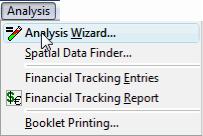
SMS Basic and Advanced Manual
Select by Legend Range
Allows the user to select a spatial object (point, line, polygon, cell) and all other spatial objects with the same legend value will also be selected.
Select Via Filter
Allows the user to select a region using data filters that the user defines. Data filters can be based on spatial statistics, attributes, and properties and in combinations.
Invert Selection
Allows the user to invert the current selection on the map, selecting all other items on the current layer other than the ones that are currently selected.
Query Tools
Query Current Layer
Activates the query feature for the current layer.
Query through Current Layer
Activates a query that cuts through all layers below the current layer, using the selected area as a "cookie cutter".
Query Multiple Layers
Activates the query feature for all layers that have been selected to be included in the multi-layer query.
Select Query Layers
Allows selection of all currently open layers in a map to be used in the multi-layer query.
Clear Query Results
Clears all the query results from the Properties Window.
Rotate Map (ADVANCED)
Allows the user to rotate the 3D view about the X, Y, and Z axis.
Hide/Show 3D View (ADVANCED)
Allows the user to toggle between displaying the current map in 2D or 3D view.
Reset Map Rotation (ADVANCED)
Allows the user to reset the orientation and zoom level of the current 3D view to the default orientation.
Dataset Playback (ADVANCED)
Allows the user to start the Dataset Playback Viewer which maps the data in real-time based on the order, time-wise, that the data was logged.
Set Background
Allows the user to select a background(s) to be viewed on the active map.
Organize Layers
Allows the user to reorder or delete layers in the active map.
Analysis Menu (ADVANCED)
Analysis Wizard...
Select this function to run the available analysis functions such as Comparison Analysis, Equation Based Analysis,
Multi-Year Averages, etc. Analysis functions can be run on a single field, multiple fields, or across projects depending
on their type.
Spatial Data Finder...
18
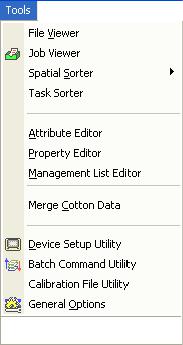
User Interface
Select this function to build and/or run a dataset filter based on Management Items and/or Properties and then generate a new map or add a new layer(s) to an existing map based on the results. For example, you can run a filter to create a map of all the Grain Harvest datasets for a certain product such as all your corn harvest data.
Financial Tracking Entries
Select this function to enter detailed production financial values such as income, expenses, expense/income shares, etc.
Financial Tracking Report
Select this option to generate a non-spatial profit/loss report that represents all the financial entries that you have made.
Booklet Printing...
Select this option to create, select, or edit a booklet design. Booklets allow you to build an output that can contain a title page, boundary maps, dataset print layouts, reports, charts, analysis results (single and multi-project), and a table of contents. The booklet is generated dynamically each time you run it.
Tools Menu
File Viewer
Utility that allows the user to view general information for files archived in the system and to reprocess files that may not have been properly entered into the management system.
Job Viewer
Opens the Job Viewer which allows the addition, editing, or deletion of Jobs and their associated Tasks from the system. This viewer can also be reached using the Job Viewer button on the main toolbar.
Spatial Sorter
Utility that sorts spatial information based on its location relative to a set boundary area. There are two options for sorting spatially:
Sort Fields into Farms
Uses a defined boundary area for a farm to sort fields with GPS into the appropriate farms.
Sort Loads into Fields
Uses a defined boundary area for a field to sort loads with GPS into the appropriate fields.
Task Sorter
Utility that sorts datasets into Tasks and/or creates new Tasks if no matches are found based on dataset sorting templates that have been defined by the user. It then sorts the Tasks into Jobs.
Attribute Editor
19

SMS Basic and Advanced Manual
Allows the user to edit and create attributes that can be used in the system. Only a few settings can be changed for system default attributes, such as display units.
Property Editor
Allows the user to edit and create user-defined properties that can be used in the system. System default properties are not editable.
Management List Editor
Allows the user to select a Management Item and add new, edit, or delete items from the list of values. This editor can be used before you read or import data into the system. It also allows you to define Resource Tracking Items such a Operator, Vehicle, etc before reading your data into the system and allowing for easier and quicker linking of data to Resource Tracking items when reading data into the system.
Merge Cotton Data
Allows users with cotton data to merge multiple pickings into a new, combined picks dataset. The user is required to specify pickings (Operational Instances) to be merged. The resulting dataset is gridded, which is required to properly total the pickings that cover the same spatial area in the same harvest season.
Device Setup Utility
Allows the user to create setup configurations containing Field names that can be exported to monitor systems from Case IH, New Holland, and Ag Leader.
Batch Command Utility
Allows the user to apply various functions, such as the addition of properties to a group of datasets, in a batch operation.
Calibration File Utility
Allows the user to edit or create calibration file groupings, called epochs. Epochs cover a period of time, by default a calendar year. If need the calibration file for a epoch can be changed or a new epoch can be created to divide a year in to two calibration groups, each with a different calibration file. This feature should not be used without first consulting with a Technical Support representative.
General Options
Provides access to general operational settings for the entire system.
Services Menu
Backup/Restore Project(s)…
Allows the user to select from the following options related to backing up and restoring projects.
Backup Project Data Now
Allows the user to generate a compressed backup of a Project(s) and the data contained in it.
Schedule a Backup for Your Project Data (ADVANCED)
Allows the user to set a day and time to regularly perform an automatic backup of a Project(s) and the data contained in it.
Restore Project Data
Allows the user to restore a compressed backup of a Project(s) and the data contained in it.
20
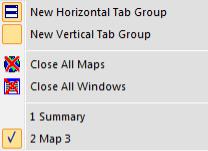
User Interface
Reprocess Files
Allows the user to reprocess data archived in the system to correct processing mistakes or reenter data into the management system that may have been deleted.
Compact Files
Utility that compacts the database to remove unused entries and optimize the database’s performance.
Remove Unused Attributes/Properties
Utility that checks the system for attributes and properties that are not linked to any datasets and then allows the deletion of these attributes/properties.
Background Layer Utility
Allows the user to manage the archived background images that have been imported or saved. This includes editing names for backgrounds, deleting them, or just viewing stats for the background files.
Legend Utilities
Allows the user to import compatible legend files from a source outside the system and export legend files to an outside location. Also allows the user to reset the current default legend settings to the factory defaults.
Map Settings Utility
Allows the user to reset the Layer, Sub-layer, and Attribute/Property settings for a selected operation(s), back to the system default settings.
3D Plot Settings Utility (ADVANCED)
Allows the user to reset 3D Plot settings that have been saved.
Vault Utility
Allows the user to delete unwanted copies of import files that are stored in the data vault on your computer. These files can take up large amounts of hard drive space and may not be need to be kept on your computer. The imported data from these files will remain in your system either as datasets in your management tree or as backgrounds until you delete them.
Transfer Utilities
Allows the user to Import/Export system settings and setup files for use in another system or other projects in your system.
Note: Transfer is only supported between systems that are running the same version of the software.
Import Setting and Files...
Allows the import of a transfer file. You can also selectively chose from the contents of Transfer file to only
import the setting and setup files that you want.
Export Settings and Files...
Allows the export of a transfer file containing selected settings and setup files.
Open Transfer File...
Allows the user to open an existing transfer file to view it contents and make changes if needed.
Window Menu
New Horizontal or Vertical Tab Groups
Organizes one or more tabs into horizontal or vertical groups. This allows you view and manage multiple windows at once, such as being able to view multiple maps in their own windows at once or a summary and a map at the same time.
Close All Maps
Closes all the windows/tabs that are map based that are currently open in the program.
21
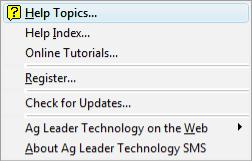
SMS Basic and Advanced Manual
Close All Windows
Closes all the window and documents that are currently open in the program.
Active Windows List
Lists the windows that are currently open and which one is active.
Help Menu
Help Topics
Opens the Table of Content for Help.
Help Index
Opens the Index for Help.
Online Tutorials…
Opens the SMS Tutorial located on the SMS CD. The tutorial contains step by step descriptions and video for some of the more important functions in SMS.
Register…
Allows the user to register their copy of the software. Registration is handled via the internet by default. If you don't have an internet connection then you can register by telephone.
Check for Updates...
If you have an internet connection this tool will check to see if you have the latest release of the desktop software, and if you don't, it will provide the option to download and install the latest update to your software for you assuming you can upgrade from your current version to the latest version.
Ag Leader Technology on the Web
Provides the user with links to web sites on the Internet. The following links are currently provided:
SMS Home Page
Provides the user with a link to the main page for SMS on the Ag Leader Technology web site.
SMS Links
Provides the user with a link to a page on the Ag Leader Technology web site that contains regularly updated links to spatial data sources on the Internet that can be used in SMS Basic.
Ag Leader Technology Home Page
Provides a link to the main page of the Ag Leader Technology web site.
About ...
Version and copyright information as well as a tool to check the system information for troubleshooting.
Main Windows
General Layout
The layout of the main window is intended to help organize the large amounts of information that you will be storing, viewing, creating, editing, and analyzing. It’s also intended to reduce the learning curve associated with some other precision farming software packages by presenting a consistent and intuitive interface.
22
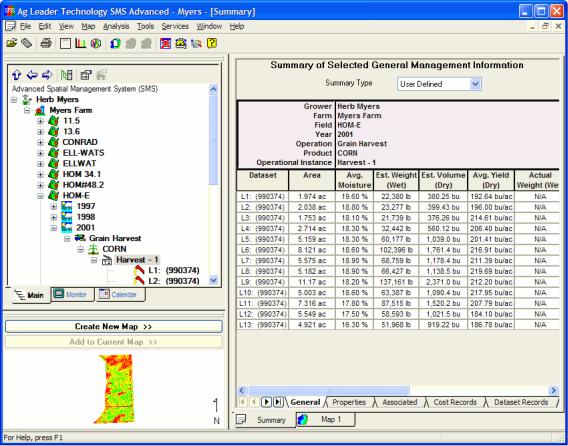
User Interface
Move the cursor over an area you would like more information about and if a hand icon appears click the left mouse button to see more information.
Management Views
About the Management Tree
The Management Tree allows you to select, manage, and view the data that is stored in the management system. It provides a visual interaction with your data when deciding what data that you would like to work with since your selection(s) is tied to what is displayed in the Preview Window. There are two tree options available, the Main Tree and the Monitor Tree. By default when the Management Tree is discussed, the Main Tree is what is normally being referenced. The Main Management Tree displays and manages data in its logical form and displays information for all types of data that have been archived, created, or imported. The Monitor Tree adds a different dimension to the data management and displays only the data that was logged by a Case IH, New Holland, or Ag Leader monitor and displays the management items as they were logged in the monitor. We call this a physical tree, which means it is directly linked to what was logged. You can view and map data based on which monitor it can from and also see what field numbers data was logged to and the names that were used. No editing or management options are available when in the Monitor Tree.
How to Information and Other Links:
Using the Management Tree Data Management
23

SMS Basic and Advanced Manual
Management Tree Toolbar Collapse
Click this button to collapse the entire management tree, closing all the branches that are currently open to the Grower Level.
Collapse Item
Click this button to collapse the management tree up to the currently selected level in the tree.
Expand Item
Click this button to expand the management tree below the currently selected level, opening all branches below the current selection.
Show Management Tree Menu
Click this button to open the Management Tree Menu. This menu can also be opened by right clicking your mouse in the management tree window.
Enable/Disable Management Tree Filter
Click this button to enable or disable the Management Tree filter. Once a filter is set you can use this button to toggle the filter on and off without having to reset or clear your filter manually.
Edit Management Tree Filter
Click this button to open a Data Filter dialog that allows you to select the management items and/or date ranges for data that you would like to be displayed in the Management Tree. For example you can select a Year filter to only show data from the current year in the Management Tree.
Edit Item
Click this button to view and/or edit the settings or properties for a selected item in the management tree.
Edit Resource Tracking
24
